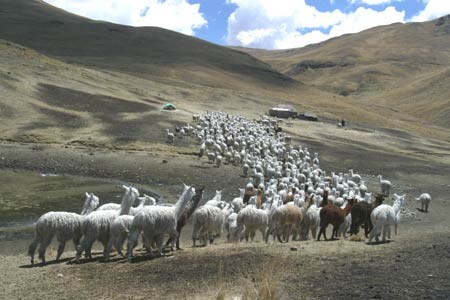About Alpacas
What is an alpaca?
Alpacas are domesticated members of the camelid family which makes them a cousin of the llama, vicuna and guanaco. There are no 'wild' alpacas - they are a farm animal. Alpacas grow to about 90cm at the shoulder and weigh around 60-70kgs. They can live up to 20-25 years old and will breed for most of their life, having a single cria every 11 months (twins are very rare). Alpacas have been farmed for thousands of years for their luxurious fleece and they have become popular investments and pets throughout the world. Approximately 25,000 in New Zealand.
What are the different types of alpaca?
There are two breeds of alpaca. The most common being the Huacaya (wah-kai-ya) which makes up about 95% of the population. Huacayas have a 'teddy-bear' appearance with the typical crimp structure to their fleece. The rarer breed is the Suri (soo-ree) which are often described as having 'dreadlocks' because of their long hanging locks of fleece. Alpacas come in 22 natural colour shades from white through fawn and brown to black and grey.
What is alpaca fleece like?
Alpaca fleece was treasured by the ancient Inca civilisation and reserved only for Incan royalty. It was known as 'Fibre of the Gods' because of it's amazing qualities. Alpaca fleece is softer, warmer, stronger and lighter than merino wool. It is super-fine and contains almost no lanolin/grease and has less prickle factor than other fibres. The fibres do not retain water and can resist heat. The fibres retain their luxurious sheen even once processed. The fleece is in high-demand in the apparel industry and commands high prices. The potential for the apparel industry is huge for both manufactures, spinners and weavers. A fibre that is fine, yet soft, with a high comfort factor and excellent thermal qualities will surely endear itself to the discerning public and ensure a successful future for the alpaca industry.
How do you look after alpacas?
Alpacas are relatively easy to look after compared with most other livestock. Usually, 4-6 alpacas can be accommodated on an acre depending on diet and management. Alpacas must be kept with other alpacas or they will become very stressed. Generally, access to pasture, hay and fresh water will keep alpacas happy. They do not require special fencing or elaborate shelter. Unfortunately, alpacas can be susceptible to facial eczema and rye grass staggers. However, they do not suffer from flystrike and footrot or need tail docking and crutching. Alpacas do not ringbark trees and are gentle on paddocks with their padded feet.
Their basic care includes:
* Shearing (around November)
* Toe-nail trimming (6 monthly)
* Vitamin D injection (6 monthly)
* Drenching (if necessary)
* 5-in-1 Vaccination (optional)
We recommend this New Zealand book for more information about owning and keeping alpacas - "A Place for Alpacas: by Cilla Taylor"
Why do people have alpacas?
Alpacas continue to be a vibrant and stable investment. Quality bloodstock have held their value for over 20 years. For example, the top-priced alpaca sold for $40,000 at the 2009 National Alpaca Show and prices for other elite animals have reached well over $150,000. However, the average quality alpaca is now at a reasonable price to attract more breeders to collectively produce commercial quanities of fleece. The fibre industry is growing as more commercial quanities are in demand. Several mills around the country process alpaca fleece and the fibre is in high demand by local craftspeople, national business ventures and internatonal fashion houses of Europe. Did you know that alpaca garments featured at the 2010 NZ Fashion Week? Designed by Laurie Foon of 'Starfish'.
Alpacas have also become a very popular lifestyle block choice. Their exquisite looks, endearing nature and low maintenance appeal to their owners. Refer to our for sale pages.
Who can shear my alpacas?
Alpacas need to be shorn every year usually between November and January. Please contact us and we can recommend alpaca shearers available in your area.
Alpaca Farming in the Andes - VIDEO
This documentary about the Amazon shows an amazing insight into alpaca farming in the Andes.
Start the video from 4:50 to skip the introduction.





